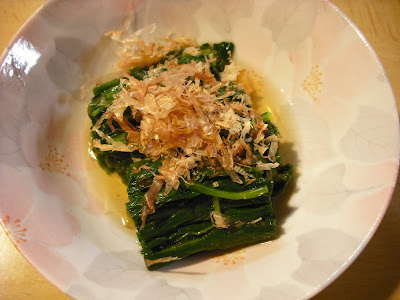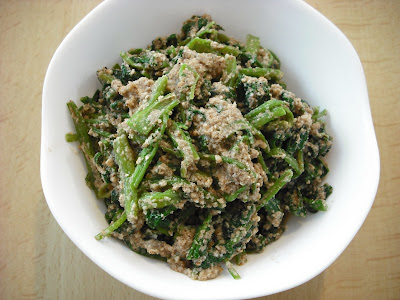One recipe calls for a dashi, soy sauce, and mirin ratio of 15:1:1, while another calls for 6:1:1. I decided to try a 12:1:1 ratio. So, I combined:
200 ml water
1/3 tsp instant dashi
17 ml soy sauce
17 ml mirin
Put them all in a pot, bring to a boil, and let cool.
Add previously boiled leaf vegetable and let stand for some time.
* Ohitashi derives from the verb hitasu (to souse, to soak, etc.). O is an honorific prefix (to be more precise, bikago (lit. beautifying word)). Ohitashi means something soused.
前に言ったように、本当の「おひたし」*は、葉野菜を茹でて、出汁、しょう油、みりんに漬けたものです。今日初めて、本当のおひたしを作りました。
あるレシピーでは、出汁としょう油とみりんの割合が15:1:1で、別のレシピーでは、6:1:1でした。私は12:1:1の割合を試すことにしました。そこで、次のものを合わせました:
水 200 ml
出汁の素 小さじ1/3
しょう油 17 ml
みりん 17 ml
全て鍋に入れて、沸騰させ、冷まします。
先に茹でておいた葉野菜を入れて、しばらく置いておきます。
*「おひたし」は「ひたす(浸す)」に由来します。「お」は敬語接頭辞(正確に言うと、美化語)です。「おひたし」とは「何か浸したもの」を意味します。

I personally didn't like it. I prefer having boiled leaf vegetable with ponzu and katsuobushi (dried bonito shavings). To my surprise, my children said they liked it. My wife also said it was good.
私自身は気に入りませんでした。茹でた葉野菜をポン酢と鰹節で食べるほうが好きです。驚いたことに、子供たちは好きだと言い、妻も美味しいと言いました。
Komatsuna goma ae tastes very good!
コマツナのゴマ和えはとても美味しいです。

Spinach goma ae tastes better, though.
ほうれん草のゴマ和えのほうが美味しいですが。
Last Saturday, I made ramen for lunch. I used boiled ohsakina as a topping. The ohsakina soaked in the ramen broth was very good!
先週の土曜日、昼食にラーメンを作り、茹でた大崎菜を載せました。ラーメンスープに漬かった大崎菜はとても美味しかったです!

The ramen broth for 4 servings was:
1,200 ml water
100 ml soy sauce
1 tsp instant dashi
(dashi to soy sauce ratio = 12:1)
1 chicken thigh
1 bunch upper green, inedible part of naga negi (Japanese scallion)
4人分のラーメンのスープは:
水 1,200 ml
しょう油 100 ml
出汁の素 小さじ1
(出汁としょう油の割合=12:1)
鶏の腿肉 1枚
長ネギの上の青い、食べられない部分 1把
Ramen noodles that I used:
使ったラーメンの麺:

Firm, aged noodles. They were good!
コシの強い熟成麺。美味しかったです!
6 comments:
I'm totally puzzled by your claim that this is the first time you made real ohitashi. I'm an American living in the US and I've made this endlessly (the real version, I assure you).
Do you really mean first time ever? Interesting.
Arthur3030: The fact that you are an American living in the US and you have made the real version endlessly is much, much more interesting!! (laugh, laugh)
The thing is, the un-soused version is what I grew up with. My mother simply boiled spinach, and my father had a bad habit of "pouring" too much soy sauce over it, like so many other Japanese at that time (1960s). (Ponzu was unknown to my family then.)
Ah. Maybe it is, at that. This didn't occur to me when I posted :)
Anyway, I always enjoy your Posts. Thanks.
Ponzu reminds me of some ancient roman recipes: mixing cooked vegetables or cooked greens or meat dishes with vinegar (or juice from unripe green grapes or squeezed sorrel leaves), fishsauce (modern times ask for nam plah - it is the same as roman garum/liquamen) and a sweet sirupe based on grapes. Taste buds are the same - even compared with taste buds 2000 years ago.
They would have loved soy sauce for sure :-)
Kiki
Kiko: I can't go back to 2,000 years ago, but I can go back to the Heian Period, more than 1,000 years ago, when four primal seasonings were used: salt, vinegar, sake, and hishio 醤 (sauce made by fermentation).
The word anbai 塩梅 (lit. salt and ume (Japanese plum) vinegar), which referes to the importance of the two seasonings, is still used today (for different meaings).
The exact origin of ponzu is unknown, but it's probable that it was made in the Edo Period.
It's no exaggeration to say that soy sauce has changed the course of Japanese cuisine completely. This should be an interesting topic to discuss in the future.
Kiki: Sorry, not Kiko but Kiki!
Post a Comment